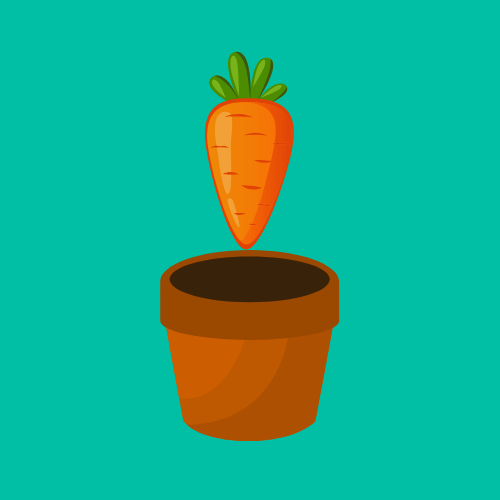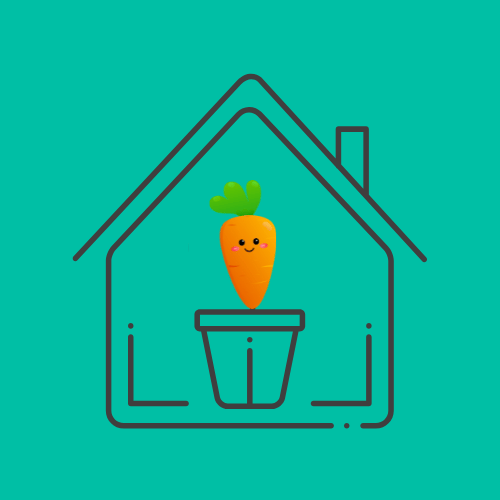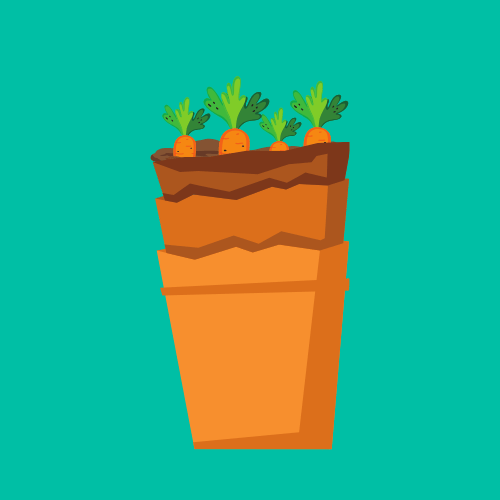How to Grow Carrots Indoors [Complete Guide]

Growing carrots indoors is an excellent option for gardeners of all skill levels. Growing carrots indoors allows you to enjoy fresh, homegrown produce all year long.
This guide will walk you through each step, offering practical tips and advice to help you grow wonderful carrots.
Get our Gardening Buddy and find veggies that fit your conditions best.
You Can Grow It!
Why Grow Carrots Indoors?
Growing carrots indoors isn’t just practical—it’s exciting! Here are a few compelling reasons to start:
- Fresh Produce Anytime: With indoor gardening, you’re not limited by seasons. Enjoy fresh carrots even in winter if you supplement with lightings.
- Pest-Free Environment: No need to worry about burrowing pests or insects damaging your crops.
- Control Over Growing Conditions: Adjust light, water, and temperature to create the perfect environment for your plants.
- Space-Friendly Gardening: No yard? No problem! All you need is a sunny spot and some pots.
Indoor gardening can also double as a relaxing hobby. Watching your carrots grow from seeds to fully edible roots is deeply satisfying.
Also check out: Top Vegetables You Can Grow Indoors.

What You’ll Need to Grow Carrots at Home
Choosing the Right Container
Carrots require space to develop their roots. Select a container that’s at least 12 inches deep, though deeper is better for longer varieties. Ensure the pot has drainage holes to prevent waterlogging. Popular choices include:
- Plastic or terracotta pots
- Wooden boxes lined with plastic
- Upcycled containers like old buckets (with holes drilled at the bottom)
Selecting the Right Soil
Carrots thrive in loose, well-draining soil. Standard garden soil often contains clumps and rocks, which can deform carrots as they grow. Instead:
- Use a high-quality potting mix.
- Add sand or perlite to improve drainage and texture.
- Mix in compost sparingly for a gentle nutrient boost.
Picking the Perfect Seeds
Not all carrot varieties grow well indoors. Smaller, faster-growing types are ideal because they adapt better to container environments. Look for these varieties:
- Nantes: Known for their sweet flavor and straight roots.
- Chantenay: Shorter and thicker, perfect for smaller pots.
- Thumbelina: Round, bite-sized carrots that mature quickly.
Consider buying organic or heirloom seeds for the best flavor and fewer chemicals.
Lighting and Location
Light is crucial for carrot growth. A sunny windowsill that gets 6-8 hours of direct sunlight daily is ideal. If natural light is insufficient (for instance in the winter), invest in grow lights:
- LED Grow Lights: Energy-efficient and customizable for different stages of growth.
- Fluorescent Lights: Budget-friendly and effective for leafy greens and root crops.
Set the grow lights to mimic daylight, running them for 12-16 hours daily. Place the pots in a room with stable temperatures between 60°F and 75°F for optimal growth.

Step-by-Step Guide to Growing Carrots Indoors
1. Preparing the Soil and Pot
Fill your container with the prepared potting mix, leaving about an inch of space at the top. This prevents water from spilling over the edges when you water.
Pro Tip: If your mix feels dense, fluff it up by mixing in more sand or perlite. Carrot roots grow best in soft, crumbly soil.
2. Planting the Seeds
Sprinkle the seeds evenly across the soil surface, ensuring they are spaced about an inch apart. Cover them with a thin layer of soil (no more than 1/4 inch thick). Pat the soil gently to settle it.
Water the soil lightly to moisten it. Keep it damp but not soaking until the seeds germinate, which typically takes 7-14 days.
3. Managing Watering Needs
Watering is essential but requires care. Overwatering can lead to root rot, while dry soil can stunt growth. To strike a balance:
- Check soil moisture daily by pressing a finger about an inch into the soil.
- Use a watering can with a gentle spout to avoid disturbing young seedlings.
- Reduce watering as seedlings grow, allowing the top layer to dry slightly between sessions.
4. Thinning Out Seedlings
Once the seedlings are about 2 inches tall, it’s time to thin them. This step is crucial for proper root development. Use scissors to snip the weaker plants at the soil line, leaving 2-3 inches of space between each seedling.
Why Thin?
Overcrowding forces carrots to compete for nutrients and space, resulting in small, misshapen roots.
5. Supporting Growth with Fertilizer
Carrots don’t require heavy feeding, but a little boost helps. Every 4-6 weeks, use a diluted liquid fertilizer rich in phosphorus and potassium. Avoid nitrogen-heavy fertilizers, which encourage leafy growth over root development.
6. Watching for Maturity
Carrots take 60-80 days to mature, depending on the variety. Keep an eye on the tops of the roots—they’ll start peeking out of the soil when they’re nearly ready.

Troubleshooting Common Carrot Growing Problems
Even the best gardeners face challenges. Here’s how to handle common indoor carrot-growing issues:
- Yellow Leaves: Could indicate overwatering or nutrient deficiency. Adjust watering habits and check fertilizer levels.
- Misshapen Roots: Often caused by compacted soil or overcrowding. Use soft soil and thin seedlings properly.
- Slow Growth: Likely due to insufficient light. Ensure plants get enough sun or invest in grow lights.
Harvesting Your Carrots
The moment you’ve been waiting for! Harvesting carrots is simple:
- Gently tug on the greens at the top of the root while supporting the soil with your other hand.
- If the carrot resists, loosen the soil around it with a small hand trowel.
- Wash and trim the greens, and enjoy your homegrown masterpiece.
Storage Tip: Store unwashed carrots in a breathable bag in the fridge to maintain freshness.

Final thoughts
Growing carrots indoors combines convenience with the joy of gardening.
By following these steps, you’ll soon be munching on sweet, crunchy carrots grown right in your home.
So grab your pots, seeds, and soil—it’s time to get planting!
Get our Gardening Buddy and find veggies that fit your conditions best.
You Can Grow It!
Partners and Sponsors
We are forever grateful to our partners and sponsors. Send an email to team @ strongecho.com and let’s see how we can grow each other’s impact!





